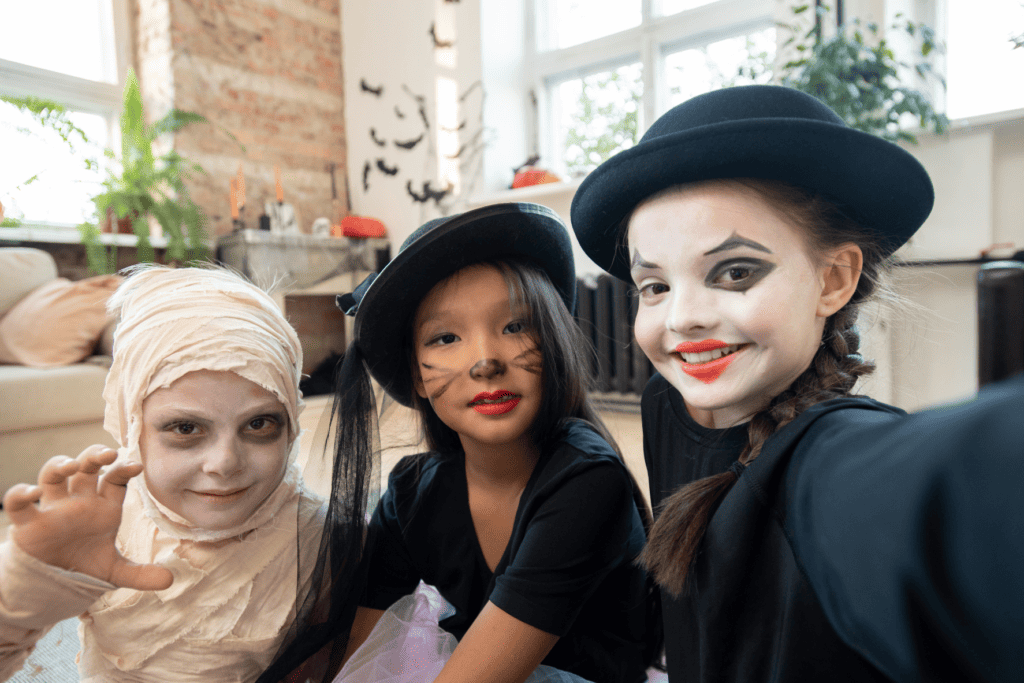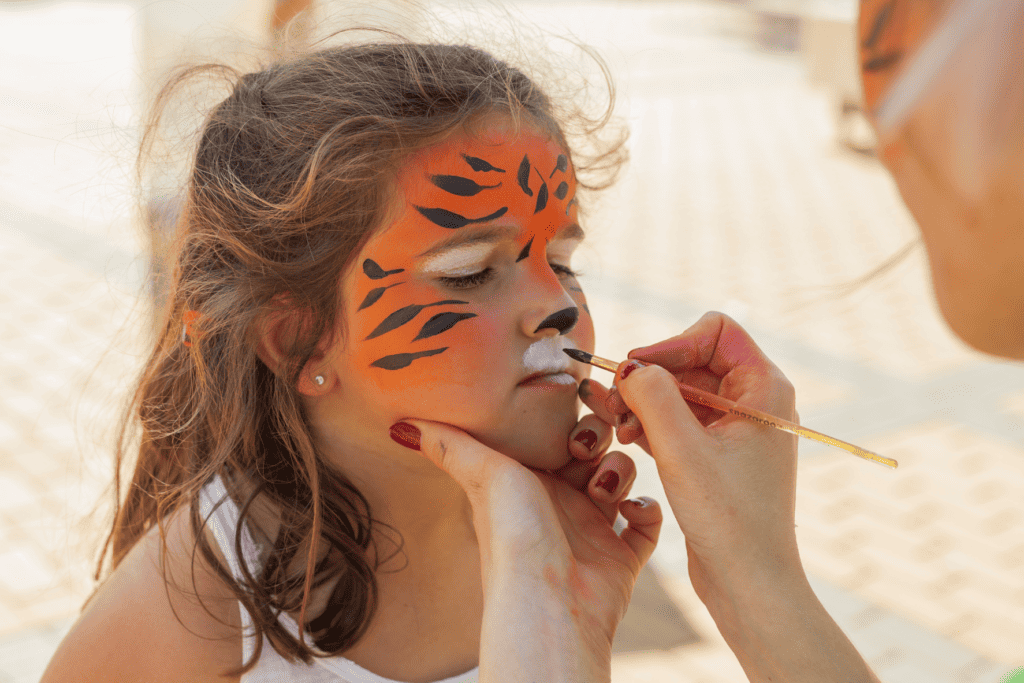Our first experience with safe and non-toxic Halloween makeup was when my daughter wanted to be a black kitty kat for Halloween when she was about six. I had heard enough allergy and contamination stories that I knew I wanted to research the ingredients first before choosing a Halloween makeup or face paint.

Ingredients in makeup and face paints can be all over the place. They may contain formaldehyde, parabens, PFAS, heavy metals and more. Halloween make up and face paint are even less regulated than regular makeup. It is almost always made in China, and it is made as cheaply as possible.
When I searched several years ago, I was fortunate to find a quality brand that I would buy again, which I’ll share later in this post. We still have plenty of the makeup left, and it still worked great as of last Halloween. So, if the price is a little higher, keep in mind that you will be able to get several years of use from it.
Why is non-toxic Halloween makeup important?
Sure, Halloween only comes around once a year, but it’s mostly used by children. Children are more affected by toxins as they are typically smaller in size and still going through essential stages of development.
Children also tend to be less careful than adults. I could compile a mile-long list of questionable things my son has touched or even put in his mouth (cringe!). Now, my less curious, conscientious daughter, not so much.
Location, location, location! Makeup is typically on or near the mouth and eyes. For these reasons, I avoid controversial ingredients as often as possible especially when the product is for my children.
Makeup Safety and Testing in the U.S.
To say it plainly, the U.S. doesn’t protect consumers the way some countries do. Our safety regulations tend to favor the manufacturer over the consumer. In the U.S., cosmetic products and ingredients do not need FDA premarket approval, with the exception of color additives. This excerpt directly from the FDA website pretty much sums it up:
Companies and individuals who manufacture or market cosmetics have a legal responsibility to ensure the safety of their products. Neither the law nor FDA regulations require specific tests to demonstrate the safety of individual products or ingredients. The law also does not require cosmetic companies to share their safety information with FDA.
I don’t know about you, but every time I read that statement, I cringe. Basically, a company can produce makeup made from any ingredients they choose to source, tell consumers it’s safe (while offering zero safety data) then sell it to anyone they like, including children.
The U.S. has banned less than a dozen toxins commonly used in cosmetics while the EU has banned over 1,300! Eek! Some well-known toxins that are allowed in U.S. cosmetics but prohibited in other countries are: formaldehyde, petroleum, parabens, triclosan, talc and synthetic fragrances.

This post contains affiliate links. I may earn a small commission for qualifying purchases. Thank you for your support!
Formaldehyde in Makeup
Formaldehyde may be listed as quaternium-15, DMDM hydantoin, imidazolidinyl urea, diazolidinyl urea, polyoxymethylene urea, sodium hydroxymethylglycinate, 2-bromo-2-nitropropane-1,3-diol (bromopol) or glyoxal in personal care products.
Common side effects are ear, nose or throat irritation as well as skin irritation. Japan and Sweeden do not allow formaldehyde in cosmetics, while Canada and the EU have heavy restrictions in place. Time and high temps promote the release of formaldehyde so tossing any low-quality makeup that you’ve had for a while may be a good idea.
Heavy Metals in Makeup
A 2013 study found concerning levels of lead, aluminum, cadmium, chromium and manganese in the majority of lipstick samples. The amounts exceeded what experts agree are safe levels of these substances.
A decade ago, asbestos and four other heavy metals were found in a cosmetic line sold by Justice and marketed to tweens. Going back to the topic of safety regulations in the U.S., did you know that over 60 nations have totally banned asbestos, but the U.S. has not?
That’s a story for another day, but hopefully you see why there is such a need to protect and advocate for your family and not assume that everything sold to us is safe.
Other Concerning Ingredients
Makeup often contains talcum powder (or talc). The Environmental Working Group (EWG) defines talcum powder as a “powdered native, hydrous magnesium silicate sometimes containing a small portion of aluminum silicate.”
The trouble with talc is that it is sometimes contaminated with asbestos fibers, which are a danger to the respiratory system and can even cause cancer. The EWG argues that even cosmetic-grade asbestos-free talc is still problematic.
Petroleum/petrolatum and mineral oil are common makeup ingredients that are derived from crude oil. The primary concern with petrolatum is the potential contamination with PAHs, which is classified as a probable carcinogen.
As for mineral oil, when it is properly and highly refined, it is considered safe, but some sources suggest that is not always the case.
Many makeups use coal tar-derived pigment. The label reads FD, FD&C or FDC and the color name. Optimistically, these pigments should only contain trace amounts of coal tar; however, the heavier the pigment, the higher the chance for increased amounts of coal tar.
Coal tar exposure is linked to various cancers and other ailments—even small amounts of coal tar in makeup may not be safe.
Non-toxic Halloween Makeup Options
I searched high and low, but only came up with two options that I felt really good about. As I mentioned, we have personally used Go Green, and it’s been great.
Admittedly, I don’t have much to compare it to, and I am no makeup artist ;). That being said, it does the job for us and has successfully created kitty kats, scare crows and a dinosaur.
Go Green Face Paint

Go Green Face Paint is made in the USA and Green Office Certified Organic. They are hypoallergenic and free of lead and petroleum-based dyes. They offer several different kits with different color combinations. The kit shown below is “Princess.”
This kit does not come with brushes. My go-to makeup brushes are from Eco Tools. They are made from recycled materials, vegan and cruelty free. Their packaging is 100% tree free. You can find them at Amazon, Target, Ulta and discount designer stores like TJ Mazz and Marshalls.
Natural Earth Face Paint Kit

Natural Earth Face Paint contains certified organic ingredients and mineral pigments. Washes off easily with water. It is made in the USA and free of nano particles, heavy metals, parabens, phthalates, formaldehyde, petroleum-based pigments and animal products.
This kit includes brushes, so that’s an added bonus!
Multipurpose your Halloween Makeup?
Halloween Makeup is essentially just face paint, so if you are searching for non-toxic face paint instead you are in luck. The products labels read “face paint,’ but in the spirit of fall, I’ve referred to them as non-toxic Halloween makeup for purposes of this post.
Keep in mind that just because these makeups are mostly natural and water-based, they can still stain fabrics. We nearly ruined my daughter’s coat the first year we used the Go Green face paints. I have made a point to warn the kids each year since then, and thankfully we haven’t had this issue again.
As always, thanks for stopping by and reading about non-toxic Halloween makeup. Hopefully one of these brands will work for your family. If you are in the market for day-to-day makeup, check out my clean lipstick post.